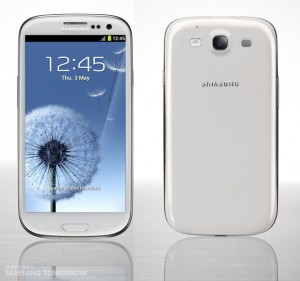Approximately once a year for the last three years Samsung has released a new flagship device: the Galaxy S. These phones are often revolutionary: the original Galaxy S brought a then-huge four inch display, along with a screaming 1GHz processor and a beautiful camera. The next Galaxy S, the Galaxy S II, brought an even better camera, along with hardware-accelerated graphics and an even better dual-core processor with more RAM. So what’s new in this year’s Galaxy S?
The answer is simple: a tightly-integrated software experience — the hardware upgrades the Galaxy S III brings are more modest. Inside, you’ll find a new quad-core processor, a vastly improved front-facing camera, and a high-resolution screen. However, it’s not the guts that Samsung wants you to look at, it’s the software.
Software: “it sees, listens, and responds”.
The Galaxy S III has what Samsung would like to call “TouchWiz Nature UX”. This is more than just a simple graphical overlay, however. Samsung clearly wants to make this a very unique device, and as such has developed some very interesting (if not somewhat creepy) software to personalize it.
In the first official television ad for the Galaxy S III, Samsung touts several new features, including the ability to know when you’re done using your phone:
This new technology uses the vastly improved front-facing camera to keep the display bright and on while you’re watching it, and turn it off when you’re done. While this sounds good, in practice phones already do this by using automatic timers.
However, a feature less touched on in the ad that may interest more people is the first true Siri competitor: S Voice. Siri, for those of you that don’t remember or don’t know, is the new voice interaction software on the iPhone 4S. With both Siri and Samsung’s S Voice, you’re able to do things like send text messages, manage your calendar, and much more. Samsung’s S Voice, which works in eight languages, also allows you to do something interesting and unique: just say “snooze” when your alarm goes off to get another few minutes rest.
Also new on the Galaxy S III is facial recognition. Coming hand in hand with its much-improved camera, this allows you to simply tap on a person’s face to go to their social network profile. You can also quickly message, call, or email them.
However, you don’t need to do only one thing at a time with your new, superpowered phone. Samsung has also upped its media ante: the camera app now opens in less than a second, and tying in with the improved hardware, allows you to take up to 3.3 shots a second. It also improved its existing Media Hub app, copying Apple’s iTunes Match by introducing Scan and Match. What Scan and Match allows you to do is scan your entire media library and allowing you access to a cloud copy on your phone.
All in all, the new TouchWiz interface is packed with new features. From what has been released, it sounds almost like they’re simply trying to cram in as many features as possible. As the devices aren’t actually out yet, it’s hard to tell, but if previous generations of TouchWiz are indicators, the interface will come out feeling a little forced and tight. Until the device is actually out, however, it’ll be hard to know whether the interface is too heavy or just right.
Hardware: a modest improvement.
While the Galaxy S III has vast improvements on the software side, it’s the hardware side that leaves people feeling underwhelmed. It’s now competing on the micro scale with other phones like the HTC One X, and it shows. The One X and the Galaxy S III are extremely similar in terms of internals.
They both weigh approximately the same amount — the Galaxy S III at 133 grams, and the One X at 130 grams. They are also approximately the same size, with the Galaxy S III being a mere 0.03 inches thinner than the One X.
However, that thinness comes at a cost. While the One X is made of one single piece of a special polycarbonate material, the Galaxy S III is made of a much cheaper feeling plastic. The One X definitely has the Galaxy S III beat in terms of look and feel.
The One X also has the Galaxy S III beat when it comes to display quality. While they both offer the same resolution (1280×720), the One X does it with a 4.7″ screen and the Galaxy S III with a 4.8″ screen, meaning the One X has mediocrely denser pixels. However, it’s not the number of pixels that matter in the case of the Galaxy S III: it’s the type of screen.
The screen on the Galaxy S III is what’s called pentile. What this means is that the screen actually has less subpixels than the One X, which has a “traditional” Super LCD 2. While not very noticable at such high resolutions, these subpixels can sometimes be the difference between crisp, clear images with beautiful colors and blurry, grainy images.
The Galaxy S III does however have some things over the One X. Its back camera, for instance, is faster and protrudes less from the back of the device. Its front facing camera is actually in a whole new league: it has a resolution of 1.9MP, or 1600×1200, as opposed to the One X’s mere 1.3MP, or 1280×1240. The S III also boasts a larger battery, with 2100mAh of life in it. That’s a lot of battery!
Conclusion
The Galaxy S III is definitely a competitor in the new market. However, based on the hardware alone, it’s not any better than the HTC One X. In fact, considering the screen, it’s perhaps even worse. The real differentiator between the two is the software, with the One X opting for a calmer experience that attempts to be beautiful, and the Galaxy S III opting to throw features at you until you’re happy. Both result in very similar phones, and with only software to differentiate them, it’s a features war.

 Email article
Email article








